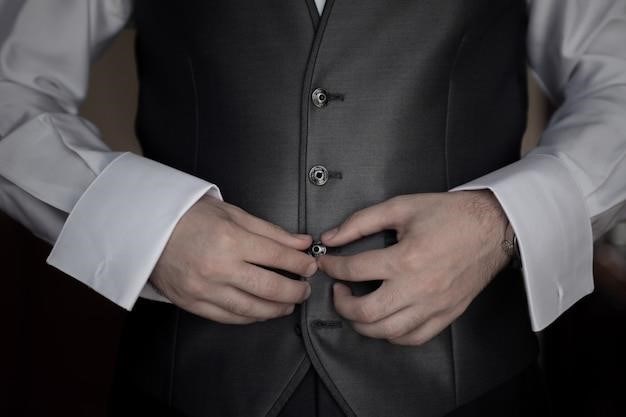tie width guide
Tie Width Guide⁚ Finding the Perfect Fit
Choosing the right tie width is crucial for a polished and stylish look. From skinny to wide, there’s a perfect tie width for every body type, lapel, and occasion. Our guide will help you find the right tie width to complement your style and make you look your best.
Introduction
The tie, a seemingly simple accessory, plays a pivotal role in elevating a man’s style. It adds a touch of sophistication and personality to any outfit, whether it’s a business suit or a casual ensemble. But with a wide range of tie widths available, choosing the right one can feel daunting. A tie width that is too narrow or too wide can throw off the balance of your entire look, making you appear either too trendy or outdated.
This guide will delve into the world of tie widths, exploring the history, the current trends, and the factors you should consider when selecting the perfect tie width for your personal style. We’ll discuss how tie width influences the overall aesthetic of your attire, and how to choose the right width to complement your body type, jacket lapels, and the occasion. By understanding the nuances of tie width, you can confidently choose a tie that flatters your physique and enhances your overall appearance.
The Importance of Tie Width
Tie width is more than just a matter of personal preference; it significantly impacts the overall visual harmony of your outfit. The right tie width can create a balanced and flattering silhouette, while the wrong width can disrupt the proportions of your suit, making you appear either too bulky or too skinny. Tie width is particularly important when wearing a suit, as it influences how the tie interacts with your jacket lapels and shirt collar.
A tie width that is too narrow can make your chest appear wider, while a tie width that is too wide can overwhelm your frame. The ideal tie width should complement your body type and create a visually pleasing balance between your shirt collar, jacket lapels, and tie. Think of it as a delicate dance of proportions, where the tie acts as a key player in creating a harmonious and stylish ensemble.

Standard Tie Widths
Tie widths have fluctuated throughout the years, but today’s standard tie widths fall within a fairly narrow range. Most modern ties measure between 3.25 and 3.5 inches wide at their widest point. This standard width offers a versatile and classic look that suits a wide range of body types and styles. It’s a safe bet for any occasion, from job interviews to weddings.
While the 3.25-3.5 inch range is considered the modern standard, there are variations to consider. Slim ties, often preferred for more contemporary looks, typically range from 2.75 to 3 inches wide. On the other end of the spectrum, wider ties, popular in the 1980s, can measure up to 4 inches wide, though these are less common today. When choosing a tie, it’s important to keep in mind that the ideal width depends on your individual body type, style preferences, and the occasion.
Choosing the Right Tie Width for Your Body Type
The right tie width can enhance your silhouette and create a balanced look. Here’s a general guideline for choosing the appropriate tie width based on your body type⁚
- Slim Men⁚ Slim ties, measuring 2;75 to 3 inches wide, are ideal for leaner frames. They help to create a more balanced appearance and avoid overwhelming your frame.
- Broader Men⁚ Wider ties, ranging from 3.25 to 3.5 inches, are generally more flattering for men with broader builds. They provide a sense of proportion and balance, preventing the tie from looking too small or lost on your chest.
- Athletic Men⁚ Athletic men have the flexibility to wear a wider range of tie widths, from 2.5 to 3.25 inches. They can experiment with both slim and standard tie widths, depending on their personal style and the occasion.
Ultimately, the most important factor is finding a tie width that you feel confident and comfortable wearing. Experiment with different tie widths and see what works best for you.
Matching Your Tie Width to Your Lapel
The width of your tie should complement the width of your jacket lapel for a harmonious and visually pleasing look. A well-balanced tie and lapel combination creates a sense of visual symmetry and elevates your overall style.
- Wide Lapels⁚ Wide lapels, typically found on classic suits, pair well with wider ties (3.25 to 3.5 inches). This combination exudes a traditional and powerful aesthetic.
- Narrow Lapels⁚ Narrow lapels, popular in contemporary styles, are best suited for slim ties (2.75 to 3 inches). This pairing creates a sleek and modern look.
Avoid mismatching tie widths and lapel widths. Pairing a skinny tie with wide lapels or vice versa can create an unbalanced and visually jarring effect. For instance, a skinny tie with wide lapels can make your tie appear lost, while a wide tie with narrow lapels can overwhelm your chest.
By paying attention to the relationship between your tie width and lapel width, you can ensure a polished and elegant ensemble.
Tie Widths for Different Occasions
The appropriate tie width can vary depending on the occasion, reflecting the level of formality and desired aesthetic.
- Formal Events⁚ For black-tie events or weddings, a standard tie width of 3.25 to 3.5 inches is generally preferred. This width exudes a classic and elegant look that complements the formality of the occasion.
- Business Attire⁚ In a business setting, a standard tie width of 3.25 to 3.5 inches is also a safe choice. This width strikes a balance between formality and modernity, conveying professionalism and confidence.
- Casual Occasions⁚ For less formal occasions, such as a dinner party or a weekend outing, a slim tie width of 2.75 to 3 inches can add a touch of contemporary style without sacrificing sophistication.
Keep in mind that these are general guidelines, and personal preference always plays a role. Experiment with different tie widths to find what suits your individual style and the specific occasion.
Ultimately, the key is to choose a tie width that is appropriate for the event and complements your overall outfit.
The History of Tie Widths
Tie widths have fluctuated throughout history, reflecting changing fashion trends and social norms. From the wide, flamboyant cravats of the 18th century to the slim ties of the 1960s, tie widths have evolved to reflect the zeitgeist of each era.
In the early 20th century, the standard tie width was typically around 4.5 to 6 inches, with bold colors and patterns prevalent. This era saw the rise of the “power tie,” a wide, often brightly colored tie that symbolized success and authority.
The 1960s ushered in a new era of slim ties, inspired by the counterculture movement and the fashion of the Beatles. Skinny ties, measuring around 2.5 inches, became the norm, reflecting a sense of rebellion and a departure from traditional styles.
Over the past few decades, tie widths have oscillated between slim and wider styles, with trends influenced by fashion designers, celebrities, and cultural shifts. Today, the standard tie width falls between 3.25 and 3.5 inches, offering a balanced and versatile option for various occasions.

The history of tie widths is a testament to the ever-changing nature of fashion and the way in which accessories can reflect social and cultural movements.
Tie Width and Fashion Trends
Tie width is a dynamic element in men’s fashion, constantly evolving with trends. The 2000s saw a resurgence of slim ties, mirroring the lean silhouettes popular in menswear at the time. These narrow ties, typically measuring 2.5 to 3 inches, added a touch of contemporary sophistication to suits and provided a sharp contrast to wider lapels.
However, the pendulum began swinging back towards wider ties in the late 2010s and early 2020s. This shift coincided with the rise of classic, tailored looks and a renewed appreciation for traditional menswear. Wider ties, measuring around 3.25 to 3.5 inches, gained popularity, offering a more substantial and balanced appearance.
While slim ties remain a stylish option for certain occasions, wider ties have become more prominent in contemporary fashion. They lend a timeless elegance to suits and complement a range of styles, from classic to modern. The resurgence of wider ties suggests a return to a more traditional approach to menswear, emphasizing balance and proportion.
As fashion continues to evolve, it will be interesting to observe how tie widths adapt to new trends. Whether slim or wide, the tie remains a versatile accessory that can elevate any outfit and reflect personal style.
The Future of Tie Widths
Predicting the future of tie widths is a sartorial guessing game, but several factors suggest a continued embrace of wider ties. The current trend towards classic tailoring and a resurgence of traditional menswear point towards a preference for more substantial, balanced looks. Wider ties, with their inherent elegance and presence, align well with this aesthetic.
Furthermore, the growing interest in vintage fashion and a nostalgic appreciation for bygone eras could also influence the future of tie widths. Wider ties were a prominent feature in menswear during the 1960s and 1970s, and their revival could be driven by a renewed appreciation for this era’s sartorial style.
However, fashion is cyclical, and slim ties could potentially make a comeback. The ever-evolving landscape of menswear often sees trends resurge in unexpected ways. Slim ties may find a new niche in contemporary fashion, perhaps as a statement piece or a way to inject a modern touch into classic looks.
Ultimately, the future of tie widths will depend on the evolving preferences of men and the direction of fashion trends. While wider ties currently hold the spotlight, the fashion world is always in flux, and unexpected shifts are always possible.
Tips for Choosing the Right Tie
Once you’ve determined the ideal tie width for your body type and occasion, consider these additional tips for selecting the perfect tie⁚
Fabric and Pattern⁚ The type of fabric and pattern can significantly impact the overall look of your tie. Silk ties are classic and luxurious, while linen ties offer a more casual and breathable option. Consider the season and the formality of the occasion when choosing your tie fabric.
Color and Design⁚ Tie colors and patterns should complement your outfit. A solid color tie can create a clean and sophisticated look, while patterned ties can add personality and visual interest. Choose colors that harmonize with your suit or shirt and patterns that aren’t too overpowering.
Tie Length⁚ Ensure your tie is the right length. The tip of your tie should reach your belt buckle when you’re standing straight. If it’s too short, it will look awkward, and if it’s too long, it will create a messy appearance.
Tie Clip⁚ A tie clip can be a useful accessory, but use it sparingly. Choose a clip that complements your outfit and avoid overly flashy or distracting designs.
Choosing the right tie width is an essential element of men’s style. It’s not just about following trends, but about understanding how tie width interacts with your body type, your outfit, and the occasion; A properly sized tie can instantly elevate your appearance, creating a polished and confident look.
Remember, there are no hard and fast rules, and personal preference plays a role. Don’t be afraid to experiment and find the tie width that makes you feel your best. With a little guidance and a few key tips, you can master the art of tie width and confidently accessorize any outfit.
Whether you’re dressing for a job interview, a wedding, or a casual gathering, the right tie width can make all the difference. So, take the time to explore different styles, find the perfect fit, and embrace the versatility of this classic accessory.
Resources
For more in-depth information and visual guides, check out these resources⁚
- The Tie Bar⁚ Offers a comprehensive tie size chart and guide, covering various tie widths and their suitability for different occasions and body types. (www.thetiebar.com/tie-size-guide)
- The Nines⁚ Provides insights on choosing the right tie width based on shirt collar size and other factors. (www.ninesparis.com/blog/how-to-choose-the-width-of-your-ties)
- DQT⁚ Emphasizes the importance of balancing proportions when selecting a tie width, ensuring it complements your body size and face shape. (www.dqt.co.uk/choosing-a-tie-size)
- KissTies⁚ Discusses the relationship between tie width and jacket lapel width, offering guidance on selecting the appropriate width for different body frames. (www.kissties.com/pages/how-to-pick-the-right-tie-size)
- TieMart⁚ Explains the current standard tie width and its versatility for various situations, from job interviews to weddings. (www.tiemart.com/mens-necktie-sizes)
These resources offer valuable insights into the world of tie widths, helping you make informed decisions and achieve a stylishly coordinated look.

